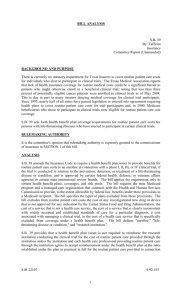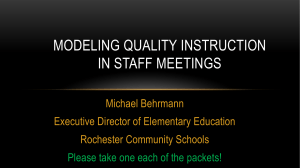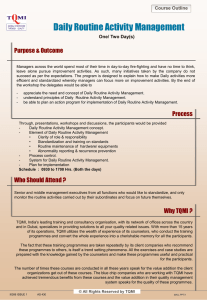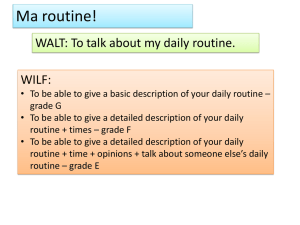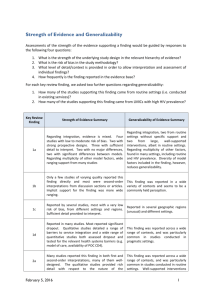Tool Selection
advertisement
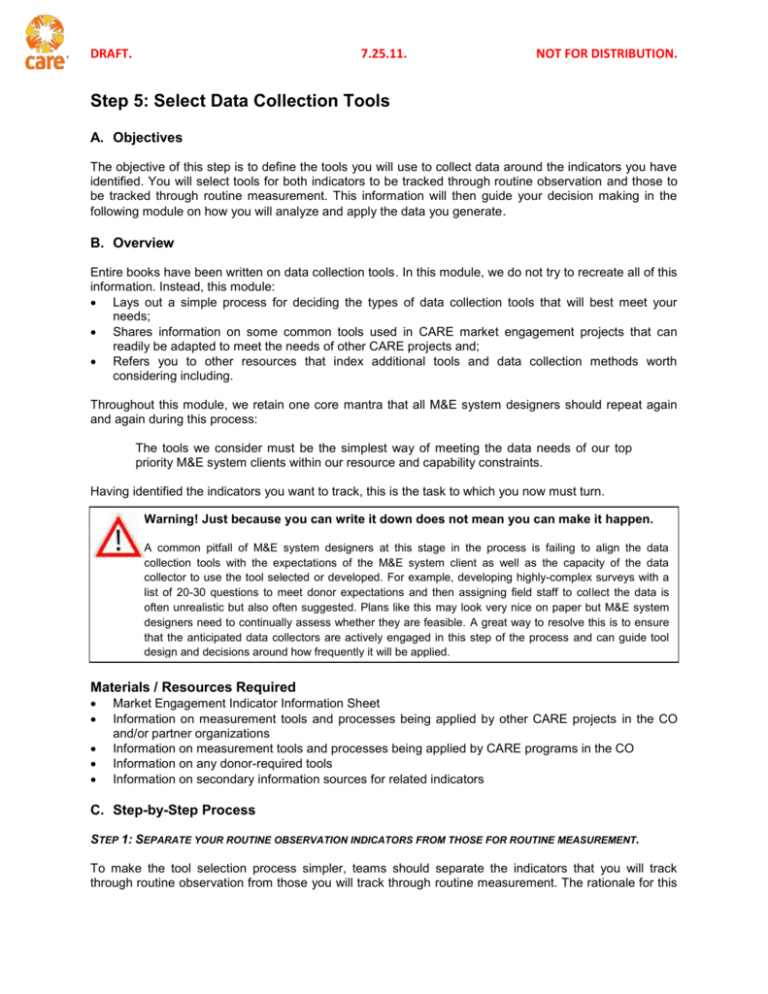
DRAFT. 7.25.11. NOT FOR DISTRIBUTION. Step 5: Select Data Collection Tools A. Objectives The objective of this step is to define the tools you will use to collect data around the indicators you have identified. You will select tools for both indicators to be tracked through routine observation and those to be tracked through routine measurement. This information will then guide your decision making in the following module on how you will analyze and apply the data you generate. B. Overview Entire books have been written on data collection tools. In this module, we do not try to recreate all of this information. Instead, this module: Lays out a simple process for deciding the types of data collection tools that will best meet your needs; Shares information on some common tools used in CARE market engagement projects that can readily be adapted to meet the needs of other CARE projects and; Refers you to other resources that index additional tools and data collection methods worth considering including. Throughout this module, we retain one core mantra that all M&E system designers should repeat again and again during this process: The tools we consider must be the simplest way of meeting the data needs of our top priority M&E system clients within our resource and capability constraints. Having identified the indicators you want to track, this is the task to which you now must turn. Warning! Just because you can write it down does not mean you can make it happen. A common pitfall of M&E system designers at this stage in the process is failing to align the data collection tools with the expectations of the M&E system client as well as the capacity of the data collector to use the tool selected or developed. For example, developing highly-complex surveys with a list of 20-30 questions to meet donor expectations and then assigning field staff to collect the data is often unrealistic but also often suggested. Plans like this may look very nice on paper but M&E system designers need to continually assess whether they are feasible. A great way to resolve this is to ensure that the anticipated data collectors are actively engaged in this step of the process and can guide tool design and decisions around how frequently it will be applied. Materials / Resources Required Market Engagement Indicator Information Sheet Information on measurement tools and processes being applied by other CARE projects in the CO and/or partner organizations Information on measurement tools and processes being applied by CARE programs in the CO Information on any donor-required tools Information on secondary information sources for related indicators C. Step-by-Step Process STEP 1: SEPARATE YOUR ROUTINE OBSERVATION INDICATORS FROM THOSE FOR ROUTINE MEASUREMENT. To make the tool selection process simpler, teams should separate the indicators that you will track through routine observation from those you will track through routine measurement. The rationale for this DRAFT. 7.25.11. NOT FOR DISTRIBUTION. is that different actors need to contribute ideas to the data collection tools you will use for each set of indicators. Typically, field staff members are not well equipped to make decisions on how you will collect indicators through routine measurement, particularly at the lagging outcome and/or impact level. This requires knowledge of best practices in evaluation and social science research and is a task for the project evaluator. By contrast, field staff are likely the most important M&E system clients to help you make decisions on the tools you will use to capture routine observation and/or traditional activity monitoring – the better aligned your tools are with their expectations and what they deem to be ‘easy to apply’ the higher quality the data you are likely to generate. Similarly, donors are usually very poorly positioned to provide input on which tools are best for capturing routine observations but will almost definitely have sound ideas – or requirements – on how projects gather data for routine measurement, again often at the evaluation level. You can separate the indicators however it is most convenient but here are two options: 1. Filter your Market Engagement Indicator Information Sheet by indicator type so that you have two versions – one version displaying only the indicators to be tracked through routine observation and a second displaying only the indicators to be tracked through routine measurement. This will help focus the M&E system clients you engage in making decision on tools. 2. Create a separate table like the one below and use it with key stakeholders to help capture decisions on which M&E tools will go into your project’s “M&E toolkit.” This option focuses on aligning all indicators with anticipated changes and displaying both indicator types (routine measurement and routine observation) side by side. Expected Change Indicator Observation Data Collection Tool Indicator Measurement Data Collection Tool *Note, not all indicators will be tracked through observation. So, you may frequently enter “NA” or “Not applicable” in the observation columns. There will be / should be many more rows filled out under the measurement co lumns. Neither of these approaches is “right,” but both could easily be applied. The important thing to focus on is helping people to see the difference between these two types of indicators so that they can make decisions on tools for tracking them. STEP 2: IDENTIFY TOOLS FOR THE INDICATORS YOU WILL TRACK THROUGH ROUTINE OBSERVATION. Once you have separated your indicators, you will want to first identify your routine observation tools. This process will require input from field staff, project managers, implementing partners as well as other key M&E system clients that will actively use this information including, possibly, the staff from the program under which your project sits or other CARE country office and organizational initiatives. (For instance, food security initiatives might consider CARE’s global food security advocacy and learning agenda to ensure lessons from your project can contribute to and learn from that broader agenda.) Note: What’s Unique about Tools for Observation? Some unique attributes of tools that support routine observation include: They involve structured interactions among stakeholders. They deemphasize quantitative measurement and focus on creating consensus around qualitative results. They are grounded in day-to-day experiences and emerging themes – allowing for flexibility as the project evolves. They involve diverse stakeholders, including impact group members in the process of periodic reflection, nurturing capacities for critical analysis, debate, and decision making. DRAFT. 7.25.11. NOT FOR DISTRIBUTION. You can go about gathering input from these M&E system clients in many ways but given that this approach is likely new to most staff and that you want to be sure that those responsible for capturing their observations feel the data collection tools are reasonable and useful for them, the best approach is likely to have a dedicated meeting on this during which participants will agree on criteria for the tools and help the M&E system designers to co-develop an initial set of tools which can then be refined and reviewed before finalizing them. At a high level, this is what M&E system designers need to consider in order to complete this step: Research and/or identify tools for routine observation that have been used in other initiatives and found to be effective. Set the expectation from the outset that field staff and implementing partners will be helping to codesign the data collection tools Develop a participatory approach to facilitating the tool selection and design meeting in order to build field staff and implementing partner ownership over the tools. Run the meeting, capture the outputs and define the process for finalizing the tools – which will likely require more meetings! Note: Don’t Waste Time and Money Once you have identified your observation tools, add them to your Indicator Information Sheet. Annex Y includes summaries of some of the tools commonly used by CARE market engagement projects to support routine observation. STEP 3: IDENTIFY TOOLS FOR INDICATORS YOU WILL TRACK THROUGH ROUTINE MEASUREMENT. This step in your design process should feel much more familiar for M&E system designers. As with all projects, you will need to identify the tools you will use to capture data on indicators you will track via routine measurement. Teams should refer to the following to determine which tools to apply to routine measurement exercises: CARE DME guidelines Donor standards or guidelines CARE Program M&E System tools Your decision making on tools to support routine measurement should be guided by the following priorities: Will the tool capture data with the right degree of accuracy to meet M&E system client expectations? Who will use the tool and do they have the capacity and time to apply it effectively? Will the data collected with the tool complicate or simplify the analysis process? Project staff and implementing partners will certainly need to collect some of the data against indicators to be tracked through routine measurement. However, often, secondary data sources exist on with the M&E system can draw in order to reduce staff data collection burdens, saving time for analysis. For the ‘big picture,’ the Bureau of Statistics, research studies, donor and business reports, trade publications, etc. might be useful sources. At the local level, community, government and other service agency records may provide relevant planning and management information. Finally, at the enterprise level, lead firms, business cooperatives/associations, financial institutions, and other value chain actors will often have individual and aggregate information on their transactions with impact group members—such as revenue, units sold, number of customers, number and value of loans, etc. In selecting tools, be sure to consider how the project might benefit from these existing data sources to reduce the burden on staff time and resources. Also consider how participatory tools could help improve performance while also reducing the data collection burden. A CARE project in the dairy sector in Bangladesh developed a “Participatory Performance Tracking Tool,” to help producer groups monitor member adoption of a set of 10 key animal management practices promoted by the project. This monthly exercise increased adoption among producers who felt social pressure to apply new practices and were able to learn from one another while also reducing the CARE data collection burden. Monthly summaries were gathered from farmer group leaders instead of reaching out to every producer each month. DRAFT. 7.25.11. NOT FOR DISTRIBUTION. Does the M&E system have the resources and capabilities to use the data in meaningful ways? Annex Z includes summaries of some of the tools commonly used by CARE market engagement projects to support routine measurement. STEP 4: ENSURE YOUR TOOLS ALIGN WITH THE NEEDS OF PRIORITY CLIENTS AND YOUR RESOURCES AND CAPACITY Now that you have identified tools for routine measurement and routine observation, the M&E system designers need to take a step back and ask the following questions: 1. Will the combination of tools we have identified allow us to meet the needs of the priority clients of the M&E system? 2. Based on our resources and capabilities assessment, can we really apply and manage all of these tools effectively? Since these are not simple questions it is important to engage other M&E staff as well as senior staff in the country office in this decision making process. This will allow you to both take advantage of their experience and build broader buy in within the CO for the M&E system you are designing. Even if you are confident that your tool selection will indeed meet the needs of priority clients and is within your resources and capabilities, you will still likely want to use this opportunity to expose these key decision makers to your progress and provide an opportunity for feedback. This will ensure that, down the line, they are advocates for the M&E system you are putting in place and can both support you and participate where and when necessary to guide project decision making. STEP 5: FINALIZE THE MARKET ENGAGEMENT INDICATOR INFORMATION SHEET The final thing that M&E system designers need to do in this step is to capture the outcomes of your tool selection process in your Indicator Information Sheet. See Worksheet X for a blank sample of this form. Note: Linking all of this to your project evaluation Much of the discussion in this module focuses on the tools CARE will use in our routine monitoring processes, both observation and measurement. There is an important linkage here with the project’s formal evaluation that need not be overlooked. CARE’s Evaluation Policy states that every CARE project must have a formal evaluation including a baseline study and an end line assessment. Much of the decision making in the preceding steps within this chapter focus on indicators to be tracked directly by CARE and/or data enumeration firms working for CARE. By contrast your project evaluation should be conducted by a third party evaluation firm and/or research institution. This partner will be best positioned to propose tools for data collection and analysis as well as how a blend of CARE’s indicators and data captured through routine monitoring (both observation and measurement) can contribute to the evaluation process. In order to identify an evaluation firm, however, teams will need to clearly articulate a terms of reference and collective expectations for what data will need to be included and what questions the evaluation will seek to address. Rather than go into a deep discussion of this in this chapter, a draft evaluation TOR and recommended resources for designing and managing good evaluations of market engagement projects is included in Annex YY. D. Case Example Work w/ CARE Peru on this. DRAFT. 7.25.11. NOT FOR DISTRIBUTION. E. Common Pitfalls M&E system designers lose sight of the diverse needs of M&E system clients leading to tools that only meet the needs of the most obvious or powerful interests – typically donors. This leads to M&E systems that prioritize precision and accuracy in all cases, even when the users of the information would prefer to focus on convenience and simplicity (i.e. project managers and field staff). A related pitfall is that projects focus disproportionately on traditional information gathering methods (periodic, formal, quantitative methods applied to large samples) and fail to utilize ad hoc, less formal, qualitative, and rapid assessment methods. M&E system designers focus on proving causation rather than considering how an M&E system oriented toward clearly demonstrating plausible attribution – or that our project likely contributed to any observed change in the value chain even if it was not solely responsible for it – might be better aligned with our resources and objectives. This focus on providing causation often pushes M&E system designers – and the evaluation firms they work with – to engineer evaluations that have very limited utility for the project implementation team and/or other CARE stakeholders. See Annex XX for guidelines on making decisions on when it is appropriate for an evaluation to focus on causation versus plausible attribution. DRAFT. 7.25.11. NOT FOR DISTRIBUTION. F. Templates and Supporting Materials Annex Y: Tools to Support Routine Observation and Measurement in Market Engagement Projects Tool Application Checklists Observation / Measurement Weekly or monthly reflection sessions Observation Staff Journals Observation Purpose / Description Provide staff with a simple framework to guide their observation of a particular project component. Use Example Costs Benefits Drawbacks The ADAPT Project in Zambia developed a checklist of 10 key components of agrodealer management. Each time they visited an agrodealer, the staff would review these areas and generate a score for the agrodealer. Very low cost Structured approach to capturing data on multiple observable characteristics Best applied when projects have a large number of common intervention points (producer groups, agrodealers, VSLAs, etc) that can be assessed against a common set of criteria Provides staff with a regular opportunity to reflect on the indicators for routine observation and exchange experiences. Capture rich learning histories on wide range of observable changes. The SDVC Project in Bangladesh held weekly field team meetings and monthly field coordinators meetings to share lessons and experiences and make operational decisions. Very low cost Loose structure can provide a channel for unanticipated lessons / challenges to be easily brought up. Without adequate planning, can lead to having meetings that do not lead to action. Under the New Partners in Value Chain Development project within CARE USA, staff members were required to develop quarterly learning journals reflecting on key components of the project, expected and unexpected Varies depending on what is expected of the journal content but, can bring high cost in terms of staff time Help to transfer experiential knowledge into explicit documentation, which can help meet needs of other M&E system clients. Can place high demands on staff time to generate the journals. Analyzing journal content is very difficult to do efficiently. Failing to use the data effectively can lead to reduced enthusiasm for the practice. DRAFT. AfterAction Review Meetings Observation 7.25.11. NOT FOR DISTRIBUTION. successes as well as challenges. and analysis demands To help a group of stakeholders reflect on a recent activity and generate lessons for improvement Following seed fairs, the ADAPT Project in Zambia convened After Action Review Meetings with representatives from seed companies, agrodealers, lead farmers and the ministry of agriculture to reflect on: how the event went, what the successes were and what could be improved. Lessons were incorporated into planning for future events. Very low cost Provides an immediate channel into which multiple stakeholders can provide input on how to improve in the future. Also helps to establish reflection and learning as a norm within the project. Given their low cost and associated benefits there are very few drawbacks to routinely supporting after action reviews. To be effective, however, these meetings need to be clearly focused and lead to concrete improvements. Otherwise, participants will lose faith in and stop participating in the process. Staff Interviews Observation To help tap into staff experiences that can add value to their peers that they may not even realize is valuable information. In support of the Market Engagement Strategy, the Economic Development Unit of CARE USA supports a series of staff interviews to share lessons on key aspects of their programming. These interviews are presented in video and written form and shared internally. Modest cost in terms of staff time but overall very low cost Provides a channel through which staff can share their experiences and lessons learned without significant demands on their time. Not all learning warrants conducting and publishing (internally or externally) the outcomes of a staff interview. So, application of the tool should be limited to topics and experiences with particular relevance and/or power to enhance the performance of the project. Stories of Change Observation / Measurement To capture snapshots that illustrate broader trends or changes observed by staff This adaptation of the “Most Significant Change,” methodology was applied by the ELMT Project in Kenya in order to provide a broad consortium with a common tool for capturing diverse observations Moderate The method may work well when a simple format is required for capturing diverse experiences. One particular benefit is Without a clear focus on a set of commonly observable changes, the stories that emerge may be difficult to compare leading to some very interesting anecdotes and /or marketing materials but little in the way of additional Staff time is the most substantial cost associated DRAFT. Secondary Data Reviews Formal Surveys Measurement Quantitative 7.25.11. Supports comparison between outcomes among project participants and a broader demographic. Secondary data can also provide valuable information on prevailing market prices, etc that are key to decision making in market engagement projects. Gather systematic evidence of project results Satisfy more rigorous data validity requirements Provide evidence of NOT FOR DISTRIBUTION. of change promoted by the project. Findings were presented and compared during learning fairs to foster crossconsortium adoption of good practices. with generating and analyzing stories. that the captured stories can help meet the needs of multiple M&E system clients. data on which decisions could be based. SDVC in Bangladesh used market price data generated by the government ant to compare with primary data gathered from project participants as well as to monitor and prepare for changes in market conditions. Very low cost Secondary data can provide a very low cost source of information to inform decision making and also understand and help to illustrate any contributions that the project has made to improved wellbeing among project participants When trying to compare participant outcomes with a broader segment of the population teams may be challenged because the secondary data is not disaggregated at the level required to do this. For instance secondary data may include information on poverty status in northwest Bangladesh but not on single, female-headed households in northwest Bangladesh that have less than 0.5 ha of land. The data that is available may not be timely. Separately, secondary data on poverty levels in the project area of operations were compared to project participant poverty levels before and after implementation to help understand SDVC’s contributions to poverty reduction. Moderate to expensive DRAFT. Focus Group Discussions Qualitative 7.25.11. Participato ry Group Tracking Quantitative project impact by attributing observed results to project activities Gather qualitative information Explore processes of change Understand changes in more depth Explore attribution Enable group (producers, cooperatives, etc) selfmonitoring of adoption of key practices promoted by the project (conservation agriculture, marketing, governance, etc) NOT FOR DISTRIBUTION. Low to moderate. The SDVC project aimed to double the dairy-related incomes of 35,000 smallholder producers, creating over 800 producer groups. To support group adoption of 10 good animal management practices, CARE created a tool using pictures representing each of the practices. On a monthly basis, groups met and, among other things, reviewed which members had adopted the practices. The results were shared with CARE field staff and aggregated to monitor group performance. Low to moderate cost, primarily associated with field staffing levels Increases sustainability, placing expectations for adoption on groups themselves rather than external monitors. Enables projects to readily collect data from large amounts of participants in cost-effective manner Enables comparisons across groups to identify high- and lowperformers Accuracy needs to be independently verified via formal evaluation. DRAFT. Ranking & Categorization Quantitative 7.25.11. Enables routine, objective assessment of participant progress and review of resource allocation toward groups and/or participants needing additional support. The ADAPT project supported a network of over 600 rural agrodealers. Each outlet was a small shop run by a trained entrepreneur and linked to larger-scale input suppliers. To assess agro-dealer progress, CARE developed an agro-dealer performance checklist, which was applied by staff during routine mentoring sessions. The results led to rankings of agrodealers in categories A, B, C and D. Supporting the transition of agro-dealers from categories B, C, and D into category A became a focus for staff and guided decision on the frequency of mentoring sessions, which decreased as agro-dealers improved. NOT FOR DISTRIBUTION. Very low cost Provides an objective measure of performance that can be routinely and inexpensively applied to participants or participant groups (CARE has also used this with producer groups). Empowers field staff and managers to make decisions on resource allocation based on clear demonstrations of performance or lack of performance. When applied by field staff, results can vary based on individual biases. Incentives for accurate reporting are not necessarily embedded as the rankings reflect on staff performance as well as participant performance. DRAFT. 7.25.11. NOT FOR DISTRIBUTION. Worksheet # X: CARE Market Engagement Indicator Information Table Result Level Domain Key Change (Wom en's Em p, (Y/N) Enterprise, Sector) Indicator Measurement Indicator Observation Target Data Users (Clients) Data Source Collection Method / Tool Collection Frequency Responsible for Collection Impact Lagging outcome Leading outcome Output Note: At this stage, you will not fill in the information in these three columns. You will do so after the next Chapter in this guide. DRAFT. 7.25.11. NOT FOR DISTRIBUTION. Annex XXX Additional Resources with Tools for Routine Measurement and Observation CARE DME Guide CARE Evaluation Policy IDS Toolkit on KM Tools DCED Results Measurement Standard


